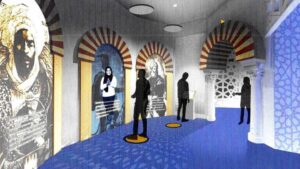1800’s
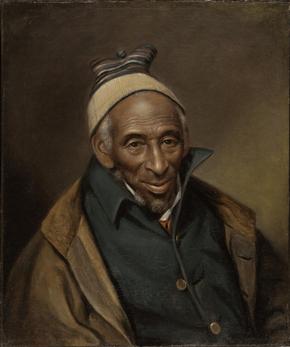
In 1807 on April 13, Yarrow (Mamout) Marmood was given his freedom by Upton Beall of Montgomery County in the Washington, DC area. He established a hauling business, owned real estate on what is now 3330-3332 Dent Place NW, and invested some of his savings into the stock of the Bank of Columbia. Yarrow lived to be more than 100 years old. The dates of his birth and death have been record as 1736-1844.
In 1803, Bilali Belali (Ben Ali) Muhammad and his family arrived in Georgia on Sapelo Island. Bilali Muhammad was a Fula from Timbo Futa-Jallon in present day Guinea-Conakry. By 1806, he became the plantation manager for Thomas Spalding, a prominent Georgian master. Bilali “Ben Ali” was the leader of one of America’s earliest known Muslim communities. While enslaved, Bilali was the community leader and Imam of at least 80 men on Sapelo Island. During the War of 1812, he told his slave master that he had 80 men of the true faith to help defend the land against the British. Bilali was known for regularly wearing his fez, a long coat, praying five times a day facing the east, fasting during the month of Ramadan, and celebrating the two holidays when they came. Bilali was buried with his Qur’an and prayer rug. In 1829 Bilali wrote a thirteen-page book in Arabic called the “Ben Ali Diary,” about some of the laws of Islam and Islamic living. The book is currently housed at the University of Georgia in Athens. Bilali and his wife Phoebe had twelve sons and seven daughters. One of his sons is reported to be the “Aaron” of the author Joel Chandler Harris’ works, Uncle Remus and Br’er Rabbit stories. Bilali daughters’ names were Margaret, Hester, Charlotte, Fatima, Yoruba, Medina, and Bint. All of Bilali daughters but Bint could speak English, French, Fula, Gullah, and Arabic. Bilali was well educated in Islamic law.
Salih Bilal known as (Old Tom) came from a powerful family of Massina in the Temourah district in West Africa. He was captured around 1782, sold to a plantation in the Bahamas, then was brought to the US around 1803. Salih Bilali lived from 1770-1846. From 1816-1840 Salih Bilali was the trusted head slave manager of more than 450 slaves of John and Hamilton Couper. It was reported by his master’s son, that while Salih was on his deathbed that his last words were “Allah is God and Mohammed his Prophet.”
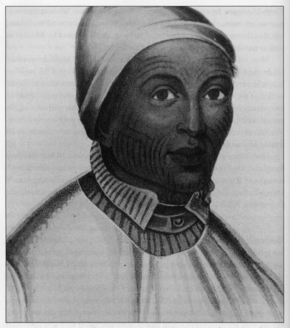
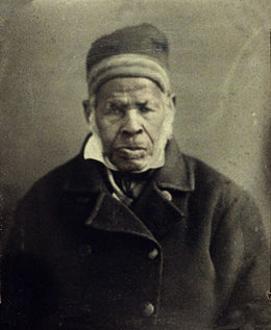
Hajj Omar Ibn Sayyid was captured in 1807, at the age of 37. Omar was a Fula born in Fur Tur in present day Senegal. He was born from a Serehule family. Omar lived from 1770-1864. He studied in Bundu, Senegal where he learned how to read and write Arabic, Islamic studies, and he made Hajj to Mecca before his capture. Omar teachers ‘Sheikhs’ were his brother Muhammad Seid, Sheikh Soleiman Kembeh, and Sheikh Gabriel Abdal. Omar was enslaved in Charleston, SC where he labored for a short period before he escaped in 1810 to Fayetteville, NC where he was caught and imprisoned. During Omar’s imprisonment he persuaded James Owen, a general in the state militia and the brother of John Owen (who later became Governor of North Carolina) to purchase him, which he did for $900. Omar became known as Uncle Moreau. Omar ibn Sayyid wrote many items in Arabic while enslaved. He wrote his own autobiography in 1831, the Lords Prayer, the Bismillah, this is How You Pray, Quranic phases, and the 23rd Psalm. Omar’s latest known writing was in 1857 in which was the Surah 110 of the Holy Qur’an.
Abdur Rahman Ibrahima ibn Sori (1762-1829) was a Fulani born in a village in Timbo, Guinea in 1762. Ibrahima left Futa in 1774 to study in Mali at Timbuktu. He was kidnapped at the age of twenty-six in 1788 and sold to the British slave traders stationed on the Gambia. Ibrahima was eventually sold to Thomas Foster in Natchez, Mississippi, and was first a field hand then rose to become the plantation overseer. He was known as the “Prince among the Slaves.” As a young man Ibrahima was a Prince and a captain of his father’s army. In 1794, Abdur Rahman married a woman named Isabella. Together they had a large family, nine children five sons and four daughters. Ibrahima was known for practicing his Islamic religion. In 1828 Ibrahima raised thirty-five hundred dollars touring the northeast and Cincinnati to help free his family. In February 1829, Ibrahima and his wife sailed to Africa. Shortly after arriving in Liberia Abdur-Rahman got cholera and died six weeks later. The following year Thomas Foster died and his heirs sold two of Rahman’s children and five of his grandchildren to the American Colonization Society, which in turn reunited them with Isabella in Liberia. Ibrahima’s son Lee, his son Simon, Simon’s wife Hannah and their five children, Simon, Susan, Cresy, Nancy, and Hester made it to Liberia.
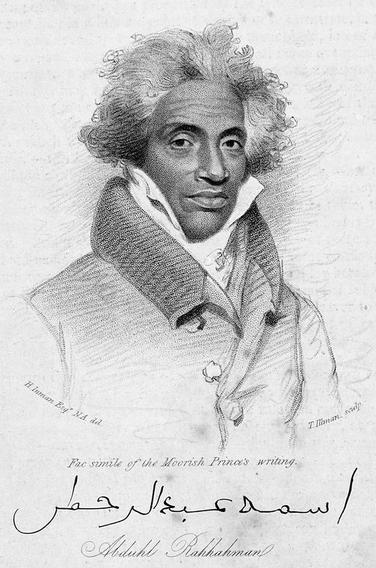

Hadji Ali, grave in Quartzsite, Arizona. In 1935, Arizona Governor Benjamin Moeur dedicated a monument to Hadji Ali and the Camel Corps in the Quartzsite Cemetery. The monument, located at his gravesite, is a pyramid built from local stones and topped with a copper camel. The monument is the most visited location in Quartzsite.
Hajji “Hi Jolly” Ali (1828 — December 16, 1902) was a Greek-Syrian specialist who was one of the first camel drivers ever hired by US Army in 1856 to lead the camel driver experiment in the Southwest. Hi Jolly became a living legend until his death in Arizona. He worked for the Ottoman armed forces and was a breeder and trainer of camels. There is no record of what his parents named him. Some sources allege his father was of Greek origins and mother was Syrian, reporting that he was born Philip Tedro and he took the name Hadji Ali after making the pilgrimage to Mecca. While other sources report his mother was of Greek origins and his father was Syrian. Hi Jolly’s membership in the Army’s Camel Experiment was not his first quasi-military adventure. Hi Jolly served with the French Army in Algiers before signing on as a camel driver for the US Army in 1856. Ali was one of the several men brought over by the American Government to drive the camels as beasts of burden in transportation across what was then, known as the “Great American Desert.” Eight of the men, including Ali, arrived at the Port of Indianola in Lavaca County, Texas aboard the USS Supply. In Go West Greek George by Steven Dean Pastis. The Americans acquired 3 camels in Tunis, 9 in Egypt, and 21 in Smyrna, 33 in all. Ali was the lead camel driver during the US Army’s experimental US Camel Corps in using camels in the dry deserts of the Southwest. After successfully traveling round trip from Texas to California, the experiment went bust, partly due to the problem that the Army’s burros, horses, and mules feared the large animals, often panicking, and the tensions of the American Civil War led to Congress not approving more funds for the Corps. In 1864, the camels were, finally auctioned off in Benicia, California and Camp Verde, Arizona. After the Camel Corps, Ali attempted to run a freight business between the Colorado River and mining establishments to the east using a few camels he kept. Unfortunately, the business failed and Ali released his camels into the Arizona desert near Gila Bend. In 1880 Ali became an American citizen and used the name Philip Tedro (sometimes spelled Teadrow) when he married Gertrudis Serna in Tucson, Arizona. The couple had two children. In his final years, Ali moved to Quartzsite where he mined and occasionally scouted for the US government. He died in 1902 and is buried in the Quartzsite Cemetery.
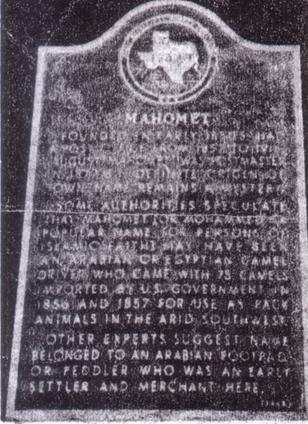
In the early 1850s, Mahomet, Texas was, founded and from 1857 to 1916, they had a post office. In 1879, August Mahomet was the Postmaster. A historical marker state’s that some reports have it that the town was named after an Arabiian Egyptian camel driver who came with 75 camels in 1856 and 1857 for use as pack animals for the US Government. While others suggest, that the town belongs to an Arabian Footpa” or Peddler who was an early settler and merchant.
In 1848 Bridgeport, Connecticut was the home to the first house built in the US with an Islamic architect style. It was, called “The Iranistan” in 1848. P.T. Barnum the famous circus entertainer had the house built after the ‘Royal Pavilion’ in Brighton, England in which P.T. Barnum had visited. The Royal Pavilion got it design style from the Muslims of British Islamic India. Today there is still a street dedicated to the Iranistan house called “Iranistan Avenue.”
From 1845-1847, records of James Hamilton from the Hopeton and Hamilton Plantations in Georgia list many families with Muslims names in them like a family with Billy (Bilal) age 50, wife Fatima age 41, children Mahomed age 17, and Hester age 15; another family Bacchus (Bakir) age 51, wife Kitty age 36, children Fatima age 5, and Adam age 3. Another family Jeffery a carpenter age 41, wife Peggy age 36, children Quash age 15, Sarah age 13, Pender age 6, Ishmael age 5, Margaret age 3, and Belale age 1; another family was led by a man named Mahomet age 25, wife Memba age 21, and one child named Jettafa age 1. There were people with name Fatima, Solomon, Michael, Binah, Ishmael, Taywah, Balaam, Cuffy, Bella, Quamina, Amey, London, Baraca, Hannah, Abraham, Jemima, Tenah, Sambo, Billy, and Mingo appears more than three times in the list.
In 1836 Lamine Kebe was known as “Old Paul,” became known to the public after Omar Ibn Said sent him a letter and the letter reached the hands of Thomas Dwight. In 1835, Lamine was liberated after being forty years enslaved in South Carolina and Alabama. Known as Old Paul he lived in New York for about year. Lamine father was a Serahule and his mother was a Mandingo. Kebe came from a family of Muslim teachers, the founders of ancient Ghana. Before being kidnap, he had a wife and three children. One of the most important things Lamine Kebe left for us is the Islamic curriculum and a list of 30 books that they used to study. Some were the Nahayi (Nahw) grammar, Fakihu, Sani, Lauan (Lughah) linguistics, Taurat (Tawhid), Yabury, and Alsara (The Risala of Ibn Zaid), Ankidutilmamy, Dequdin, Bunamara-kibura, Talakiny (Commentary on Fiqh), Aluwatriet, and others.
In 1839, Oman’s ruler Sayyid Sa’id ordered his ship “The Sultana” to set sail for America on a trade mission. The ship touched port in New York on April 30, 1840. The ship’s commander, Ahmed bin Nauman bin Muhsin Al-k’abi Al-Bahraini came from Zanzibar. Ahmed bin Nauman bin Muhsin Al-k’abi Al-Bahraini’s photo hangs today on the third floor of City Hall in New York, NY. The voyage was not a great commercial success.
In 1860, Muhammad Ali ibn Said (1833-1882) known as (Nicholas Said) arrived in America as a free man. Muhammad was born in the Kingdom of Bornu, West Africa near Lake Chad to a well-educated merchant family. Said was captured by a group of Tuaregs, enslaved and sold at the age of 16. His first slave master was an African-Arab named Abdel Kader who took him to Tripoli and Fezzan. Abd-El-Kadir sold Muhammad to Abdy-Aga a Turkish officer. Muhammad went on Hajj with the Turkish officer father Haji Daoud Aga. They traveled thru Alexandria, Cairo, Khartoum, Abysinnia, Eritrea, and Somalia to Saudi Arabia. When they came back from Mecca Muhammad was sold, to Fuad Pasha, taken to Constantinople, and given to Fuad Pasha brother-in-law Rashid who then sold Muhammad to a Russian diplomat Prince Anatole Mentchikoff who brought him to Odessa, Russia. Alexander Menshikov, an aide to the Russian Czar, then to Nicholas Troubetzkoy with whom he traveled to many places during his years of slavery from Odessa, Russia, to the cities of St. Petersburg, Vienna, Dresden, Munich, Rome, Paris, Heidelburg, and London. Around 1857, Muhammad was set free from Prince Troubetzkoy and given 300 pounds sterling. Sometime in 1857, Muhammad arrived in Canada outside of Ottawa; Said came with De Sanddrost I.J. Rochussen who asks Said for a loan. Said had loaned him the 300 pounds and Rochussen disappeared leaving Muhammad penniless. Around 1858 Said arrived in Detroit. Shortly afterward, he found a teaching job and in 1863, Muhammad enlisted in the 55th Massachusetts colored regiment and became a Civil War hero. He served faithfully and bravely with his regiment as Corporal and then Sergeant in the South. Near the close of the war, he was assigned, at his own request, to the hospital department, to learn some knowledge of medicine. His Army records show that he died in Brownsville, Tennessee in 1882.
Another group of people with Islamic roots is the Ben Ishmael. Reports state that around 1785 a number of freed and runaway Africans, along with poor white indentured servants fled Noble County, now “Bourbon” County, Kentucky and settled near what is today Indianapolis. They intermingled with the Pawnee and Kickapoo tribes and setup a nomadic life style. Their leaders were Ben and Jennie Ishmael they were known as fine artisans and musicians. They taught polygamy, a nomadic existence, and racial mixing. The Tribe of Ishmael called the Ishmaelite was a tightly knit nomadic community of Africans, Native Americans, and white descent. They were estimated to number about 10,000. By 1810, they had developed three villages Mahomet, Illinois, Morocco, and Mecca, Indiana. In James F. Cooper’s 1827 book, Prairie he speaks of Ishmael and other members of their community like Abraham, Asa, Abiram, Esther, Mahtoree and others. He writes, Ishmael said “Peace!” stretching his heavy hand towards his kinsman, in a manner that instantly silenced the speaker. In Hugo P Leaming’s book, The Ben Ishmael Tribe: a Fugitive ‘Nation’ of the Old Northwest, he points out that Cooper’s fictional Ishmaelite’s and the historic Tribe of Ishmael coincide in most particulars. Cooper calls his tribal chief Ishmael Bush as the name in reference to the wilderness he rules. He also said the tribe has been called by various names “the sons of skirting Ishmael,” (meaning skirting the settlements), “the sons of Ishmael,” “the tribe of wandering Ishmael,” (referring to their nomadic way of life), and “Grasshopper Gypsies.” Their annual migratory route was northwest from Indianapolis to the Kankakee River south of Lake Michigan, from there south through eastern Illinois to the area of Champaign-Urbana and Decatur, and due east, back to Indianapolis. Their migration was, repeated for years until the forced Indian removal in the 1830s.
In 1880, a Minister named O.C. McCulloch wrote, “the Tribe of Ishmael: A Study in Social Degradation in favor of castrating the men and separating the children and women.” In 1905 a bill was introduced in the Indiana Legislature and in 1907 the first compulsory sterilization law in the world, a draconian eugenics law, in which was enacted in Indiana against the Ishmaels and forced many Ishmaels to flee Indianapolis for Chicago, Detroit, and other cities. From 1897-98 there was a monthly magazine called the “Ishmaelite,” from members of the Ben Ishmael tribe in Cincinnati, Ohio.
In Leaming’s book, it sites following the Indiana plan and the community dispersal that some members of the Tribe of Ishmael had an impact on the development of Black Nationalism and Self-Determination in communities of the cities of the Great Lakes region. He records many different testimonies; one about a Moorish Science Temple member Mrs. Gallivant, who had joined in Detroit around 1920, when it was first introduced into the Midwest. She stated that she was an Ishmaelite who came from downstate Indian and Illinois and that it was the Tribe of Ishmael after moving north who were among the first to assist in the establishment of Moorish Science in the Midwest in the 1920s. Hugo Leaming also points out one of the sayings of Noble Drew Ali, the founder of the Moorish Science Temple, that he was moving his National Temple from New Jersey to the Midwest because Islam is closer to the region. He also asked one to ponder and re-look at the early name and phrase of the Nation of Islam that we are members of “The Lost Found Nation in the Wilderness of North America.” The Nation of Islam even had its’ headquarters first in Detroit than Chicago.
Leaming sites curious aspects of the old Midwest communities located on the Ishmaelite annual migration route at the northern end is Morocco, Indiana, at the southern end Mahomet, Illinois, and at the stage of their journey before going to Indianapolis was Mecca, Indiana. In Morocco, a few miles south of the Kankakee River near the Illinois border, the area is distinguished by small, long round-roofed cabins shaped like Quonset huts (or Hobbit houses), or dome shape roofs, which most of them today stand in the yards of newer houses and residences. Two other points he brings out is that a few miles northwest into Illinois is a small rural isolated village in the town called Pembroke, which has a Moorish Science Temple and that a few miles northwest of Pembroke in Kankakee, which is the smallest town in America to have a Temple of the Nation of Islam.
Mecca, Indiana was another township where the tribe of Ishmael settled and migrated. Mecca, Indiana also called Mecca Mills, which is three miles west of State Road 41 about five miles southwest of Rockville, which is on the Big Raccoon Creek not far from Wabash.
In the Federal Writer’s 1936 project, the report states that the church has spoken of, as Leatherwood is upon a dry and sandy hill, for this reason, it was, called the Arabian Church. It goes further and says that the people of the vicinity of the church came early each spring after the roads became passable to the store of Alexander McCune, who made smart remarks about the Arabians who were coming on the annual visit to Mecca. One of the requirements of the Mohammads’ religion is to visit Mecca the birthplace of Mohammad (SWT), once a year. The Federal Writer’s report also states that in 1832 Alexander McCune and Samuel Lowery built a sawmill on Big Raccoon Creek in Wabash Township. They were some of the early settlers into the area after the forced removal of the Native American Indians and the tribe of Ishmael from the area.
In 1855, soon after the village was, started McCune and Lowery built a flour-mill near their other mills. The Mecca Bridge is a covered bridge built in 1873 and in 1896, Edward Goff plotted the first lots for deeds of conveyance for which provided, that no intoxicating liquors should be sold thereon. The purchaser who disregarded this provision forfeited his title to the lot. According to the Writer’s report, there were at least 284 people between the two clay plants owned by the Dee Company and the Indiana Sewer Pipe Co. By 1900, the grist mill equipment was, sold and the mill was, converted into a store. The plants started closing around the 1940-41s during the depression. W. E Dee was the president of the bank of Mecca, which operated for twenty-five years and closed at the beginning of the depression. The report also speaks about two distinguished people in the person of William E. Dee and the Hickson ‘Hixon’ Family. Many of the families in Mecca had named one of their sons with the name Aquilla. In the 1860 Census, there was an Azanah Brown and his family and a Saluda a Hayth and her family listed living in the area.
Another town named Mahomet is in Texas about twenty-five miles south of Lampasas, Texas. Mahomet, Texas was founded in the 1850’s and had a post office from 1857-1913. August Mahomet was the postmaster in 1879. Some say the town was, named after a man named Mahomet who came to the United States with some other camel herders and seventy-five camels that were, imported by the Government in 1856 and 1857 to be, used as pack animals. While other says it was, named after an Arabian peddler who was an early settler and merchant. The Mahomet, Texas name has been associated with two sites in eastern Burnet County. A George Ater settled in the area in 1853, and named it Mahomet, Illinois. In 1855, a stage route was, established from Austin to Lampasas and in 1857; George Ater was, granted permission to open a post office location in his house. The post office remained in his house for twenty-five years. In 1882, the railroad had bypassed Mahomet by at least two miles. The post office was, then moved to the house of Alex M. Ramsey in the Sycamore Springs community, which later became, known as Mahomet in 1884. Mahomet had a steam cotton gin and a corn mill. By 1896, the mill had closed and the population had declined. By the 1980s, the population has stayed between forty to forty-seven people. There are more than 500 names of places, villages, streets, towns, cities, lakes, rivers, etc . . . in the United States in which their name are derived from Islamic and Arabic words. Places like Mecca, Indiana; Morocco, Indiana; Medina, NY; Medina, OH; Medina, TX; Toledo, OH; Mahomet, IL; Mahomet, Texas; Yarrowsburg, MD; Islamorada, FL, and Tallahassee, FL are, found throughout America.
Reference Sources:
The Federal Writer’s report; The Ben Ishmael Tribe: a Fugitive ‘Nation’ of the Old Northwest, by Hugo P Leaming; The Jews of Charleston, Charles Reznikoff; Roots: The Saga of an American Family, by Alex Haley; “The Journals of the House of Representatives 1789-179 called the “Free Moors Act;” The Tribe of Ishmael: A Study in Social Degradation in favor of castrating the men and separating the children and women, by O.C. McCulloch; Continental Troops roll records; Gone To Croatan: Origins of North American Dropout Culture, Ron Sakolsky & James Koehnline; Muslims in America: Seven Centuries of History, Amir Muhammad; The Prairie, James F Cooper and The Fortunate Slave, by Grant.
The Autobiography of Nicholas Said, A Native of Bournou, Eastern Sudan 1873. James Hamilton records from Hopeton and Hamilton Plantations 1837-1852

